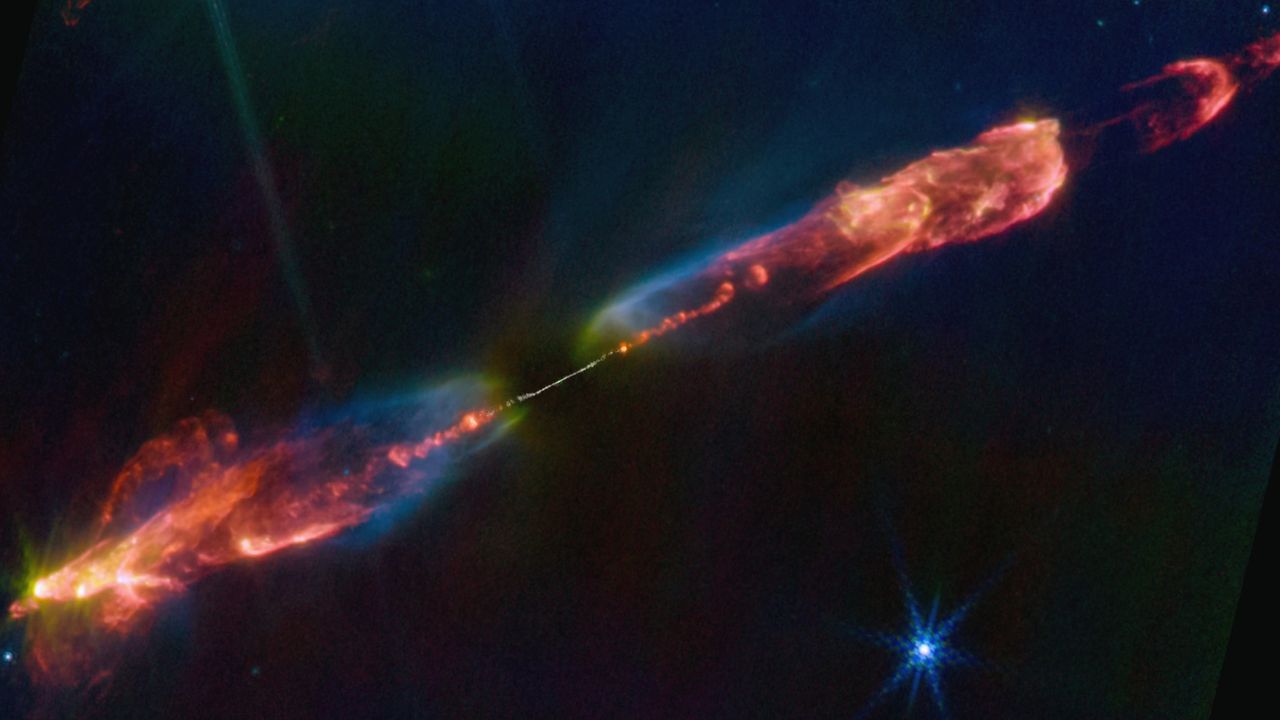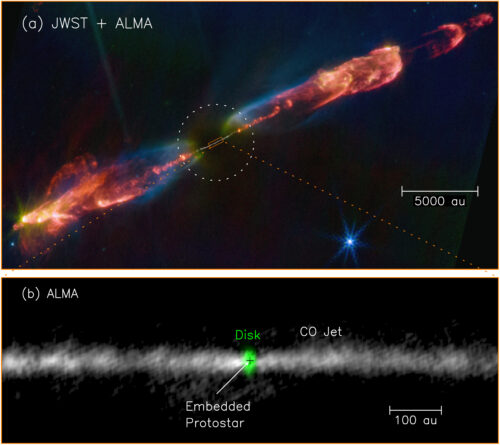
What it is: HH 211, a baby star erupting with gargantuan energy jets
Where it is: 1,000 light-years from Earth in the constellation Perseus.
When it was shared: Sept. 17, 2025
Most events in the universe are not fully understood, including the relatively simple process of star formation. Stars form in dense clouds of cold gas and dust. When these clouds reach a threshold mass, they collapse under their own gravity, leading to the birth of a baby star, or protostar.
As these young stars form, they pull matter from their surroundings, developing a swirling disk of gas and dust around them known as an accretion disk. This material rotates, clumps together and gradually falls into the star, enabling it to grow bigger.
If the accretion disk spins too fast, the material can't easily fall toward the star. Astronomers believe that baby stars blast away some material in the accretion disk in the form of energetic jets — known as protostellar jets — which may ease the process of some material moving into the star.
But the main challenge in confirming this is that these jets come from regions very close to the star, which means the jets can't be seen or imaged, even by some of the most powerful telescopes. Therefore, astronomers don't know how they are ejected or where these jets start.
Researchers have previously proposed that the magnetic field in the protostellar system could help launch these jets. And a new image has helped shed light on this for the first time.

In a study published Aug. 13, in the journal Scientific Reports, researchers used the Atacama Large Millimeter/submillimeter Array (ALMA) in Chile to investigate an object called HH 211, located 1,000 light-years away in the constellation Perseus. HH 211 is a Herbig-Haro object — a bright region of nebulosity created by the powerful jets of newborn stars. This protostellar system is only 35,000 years old, with a tiny central protostar weighing only 0.06 times the sun’s mass.
HH 211 features a bright bipolar jet — two beams of energized ionized material emerging in opposite directions. This system is one of the few known instances where a magnetic field has been detected, offering a rare opportunity to explore the magnetic field-driven ejection models.
The ALMA observations of this system showed that the jet is rocketing at speeds of around 66 miles per second (107 kilometers per second), but interestingly, it rotates quite slowly, with a specific angular momentum. This suggests that the bipolar jet has carried away excess rotational energy. By factoring in the conservation of angular momentum and energy, the researchers calculated that the jet comes from the very inner edge of the accretion disk, just 0.02 astronomical units, or close to 1.85 million miles (3 million kilometers) away from the star.
Their results align with one of the models that explains how a magnetic field can act like a slingshot to launch gas outward.
In the spectacular image, the colorful display of the bipolar jet is captured by the James Webb Space Telescope (JWST) in near-infrared wavelengths. However, JWST's view is blocked by the thick dust surrounding the central region.
This hidden region is crucial as this is where the jet originates. Thanks to the new study, the ALMA data revealed the crucial thin part in the center in the submillimeter wavelengths. The ALMA data is overlapped here with the JWST data to create a complete picture of how new stars form. The zoomed grayscale image captured by ALMA clearly shows the jet being launched from the accretion disk.
This is the first time that the launch location of a protostellar jet has been captured. The discovery also confirms that these jets play a crucial role in the growth of newborn stars by removing angular momentum from the accretion disk, enabling material to fall easily onto the star.
For more sublime space images, check out our Space Photo of the Week archives.







